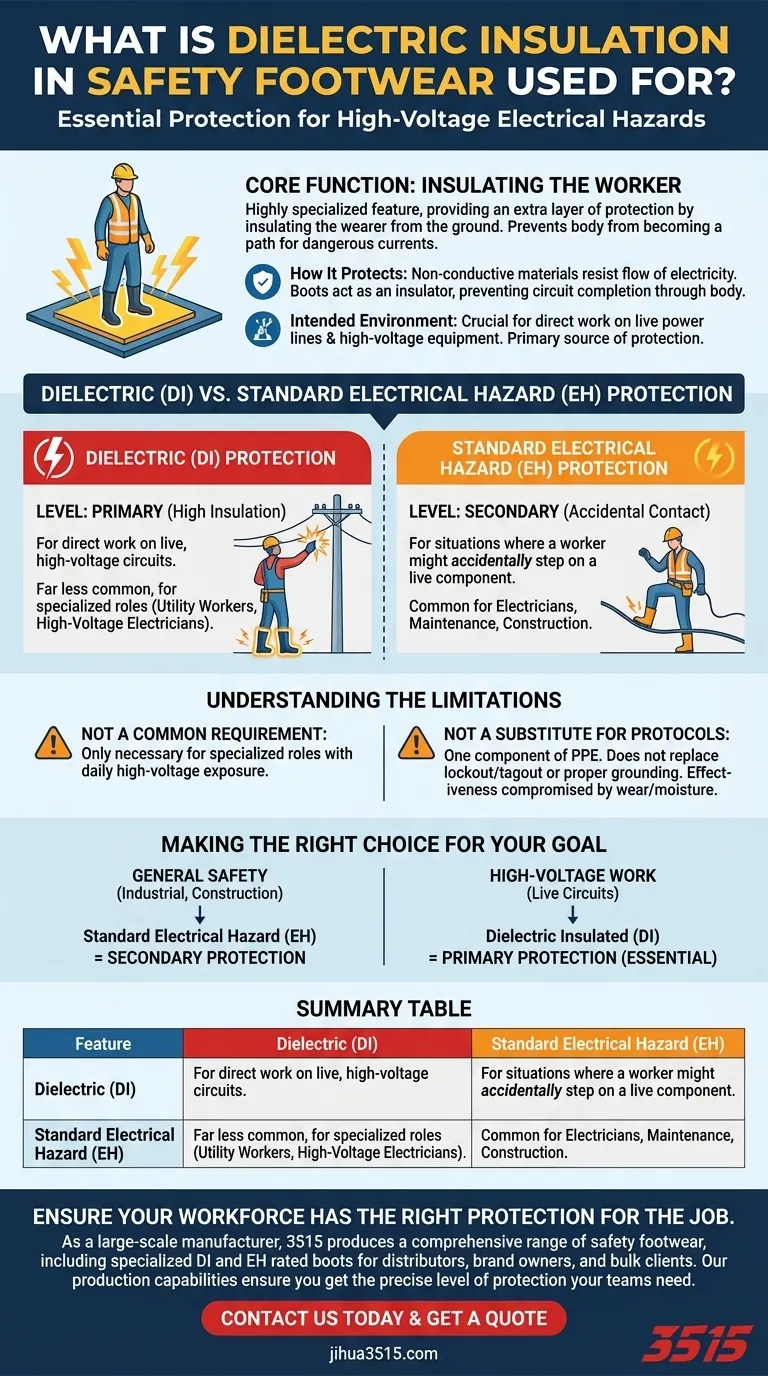In essence, dielectric insulation in safety footwear is a highly specialized feature designed to provide an extra layer of protection for workers who face significant electrical hazards. It is specifically engineered to insulate the wearer from the ground, helping to prevent their body from becoming a path for dangerous electrical currents when working with live wires or high-voltage equipment.
The critical distinction to understand is that Dielectric Insulated (DI) footwear is not the same as standard Electrical Hazard (EH) rated boots. DI offers a significantly higher level of protection required for direct work on or near high-voltage, live electrical circuits.

The Core Function: Insulating the Worker
How It Protects
Dielectric footwear is made from non-conductive materials that resist the flow of electricity.
When a worker makes contact with an energized conductor, these boots act as an insulator, preventing electricity from completing a circuit through their body to the ground.
The Intended Environment
This type of protection is crucial for workers dealing directly with live power lines and other high-voltage electrical equipment.
It is considered a primary source of protection in environments where the risk of severe electrical shock is a constant and known part of the job.
Dielectric (DI) vs. Standard Electrical Hazard (EH)
Understanding the difference between DI and the more common EH rating is vital for ensuring proper safety.
Standard Electrical Hazard (EH) Protection
Most safety footwear with electrical protection carries an EH rating.
EH-rated boots are designed to provide a secondary source of protection. They are intended for situations where a worker might accidentally step on a live electrical component.
This is a common safety feature for electricians, maintenance workers, and general construction, where incidental contact is the primary risk.
Dielectric (DI) Protection
DI footwear provides a much higher level of insulation and is considered a primary source of protection.
It is far less common and is reserved for specialized industries, such as utility workers and high-voltage electricians, who must work directly on or near energized circuits.
Understanding the Limitations
Not a Common Requirement
For the vast majority of trades, a standard EH-rated boot is the appropriate level of protection.
DI footwear is only necessary for a small subset of highly specialized roles where direct exposure to large electrical hazards is a daily reality.
Not a Substitute for Safety Protocols
Dielectric footwear is one component of a comprehensive personal protective equipment (PPE) system.
It does not replace other critical safety procedures like lockout/tagout, proper grounding, and the use of other insulated equipment. The effectiveness of the footwear can also be compromised by excessive wear, punctures, or moisture.
Making the Right Choice for Your Goal
Selecting the correct footwear depends entirely on the specific hazards you face in your work environment.
- If your primary focus is general industrial or construction safety: Standard Electrical Hazard (EH) rated footwear is the appropriate choice for secondary protection against accidental contact.
- If your primary focus is working directly on high-voltage, live circuits: Dielectric Insulated (DI) footwear is the essential and required level of primary protection.
Choosing the correct level of electrical protection is a critical safety decision based entirely on a thorough assessment of your work environment's risks.
Summary Table:
| Feature | Dielectric (DI) | Standard Electrical Hazard (EH) |
|---|---|---|
| Protection Level | Primary (High Insulation) | Secondary (Accidental Contact) |
| Intended Use | Direct work on live, high-voltage circuits | General work where accidental contact is a risk |
| Common Roles | Utility Workers, High-Voltage Electricians | Electricians, Maintenance, Construction |
Ensure your workforce has the right protection for the job.
As a large-scale manufacturer, 3515 produces a comprehensive range of safety footwear, including specialized Dielectric (DI) and Electrical Hazard (EH) rated boots for distributors, brand owners, and bulk clients. Our production capabilities ensure you get the precise level of protection your teams need.
Contact us today to discuss your safety footwear requirements and secure a reliable supply of high-quality, compliant PPE.
Get a Quote & Discuss Your Needs
Visual Guide

Related Products
- Safety Footwear Wholesale Manufacturer for Custom OEM/ODM Production
- Wholesale Safety Footwear Manufacturer for Bulk & Custom OEM Orders
- Premium Flame-Retardant Waterproof Safety Boots and Shoes
- Puncture-Resistant Velcro Safety Boots for Wholesale & Custom Manufacturing
- Wholesale Durable Safety Boots | Custom Steel Toe & Puncture-Resistant Manufacturing
People Also Ask
- How do safety shoes contribute to cost savings for companies? A Strategic Investment in Risk and Cost Management
- Is it normal to wear shoes in the house? A Guide to Hygiene, Comfort & Culture
- Do snake bite boots work? Your Ultimate Guide to Effective Snake Bite Protection
- What cultural and environmental considerations are tied to wearing shoes indoors? Balance Hygiene, Tradition, and Foot Health
- What do heavy duty boots do? Protect Your Feet in Demanding Work Environments



















